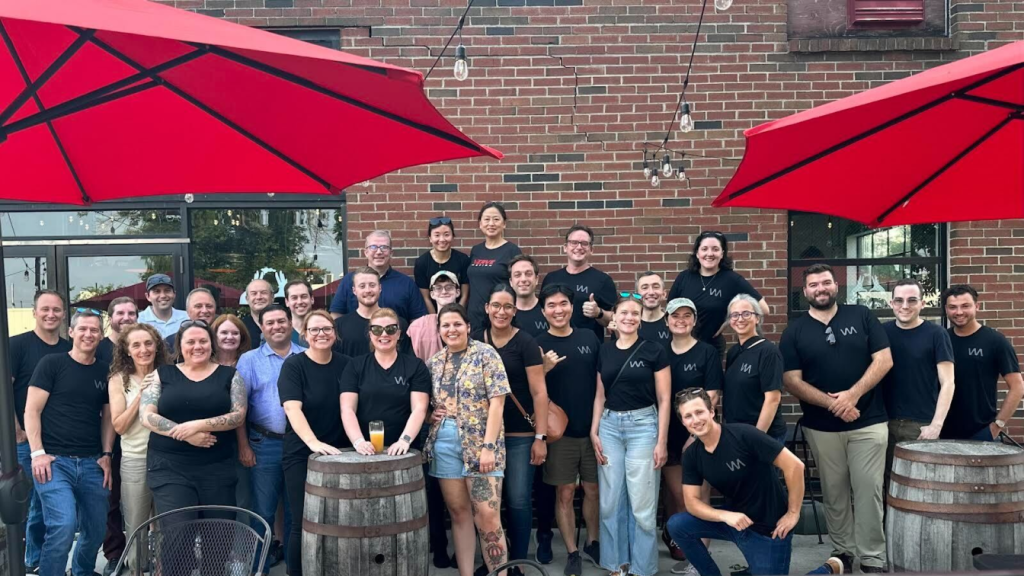
Founders: Ignacio Galiana, Conor Walsh, Mike Rouleau, Nathalie Degenhardt
Founding: 2020
Mission: Power the human workplace through people-centric robotics
Employees: 50 & 90%+ Local
Workplace: Hybrid
Stage & Capital Raised: Series B & $40M+ raised
Investors: Safar Partners, Cybernetix Ventures, Construct Capital, Founder Collective, Pillar VC and OUP
Key Customers: Albertsons, UPS, Wegmans, Stop & Shop, Hannaford
Glassdoor Rating: 5.0
Valuation (estimated): $100M+ (assuming they sold ~10-20% of the company in the $20M Q4 ‘23 Series B fundraise)
^ this is a useless number. There is no tangible valuation until the business is sold or goes public. Don’t forget it!
Verve Motion is building an industrial wearables robotics & software platform for hardworking humans.
Founded out of Harvard’s Biodesign Lab in 2020 by Ignacio Galiana, Conor Walsh, Mike Rouleau, and Nathalie Degenhardt this team has been working on the research that ultimately became the commercial startup Verve Motion for over a decade. With initial funding for military use cases (via DARPA) and continued research grants from organizations like the National Institute of Health and National Science Foundation, research has been commercialized for an industrial use case to help make humans stronger & less fatigued.
When Verve Motion was spun out of Harvard in March of 2020 (you may have been a little distracted due to COVID), the company shipped its first products within 30 days while simultaneously closing its initial round of funding. It happened to be great timing. With overstretched supply chains, borders shutting, and a stretched labor force, Verve Motion’s mission to power the human workplace through people-centric robotics was primed for the moment.
More than 80% of warehouses lack any form of automation and only 5% have utilized sophisticated automation technology (src). Almost half plan to invest in technology of some sort in the coming years and automation technologies have a $22B+ global market today. But automation is uneven and capable humans are still needed at scale to deliver physical goods to consumers through complex supply chains.
Until now, there have really been only three different ways to solve the modernization of a warehouse operation. First, you could do nothing. And frankly that’s the status quo for a variety of reasons – cost, operational complexity, not knowing where to start, and on and on. Second, you could implement an expensive robotics system like an “ironman” type suit. But…those are expensive. They’re heavy. And they’re not always ready for primetime. The third is a passive suit that might be spring based with elastic brands. These can help reduce muscle strain but are also limited in their usefulness.
Verve Motion introduced a fourth solution – an active, soft exosuit. The company launched its SafeLift exosuit as a hybrid wearable technology that wears like a backpack with leg straps. It has a robotic motor that works in parallel with your back muscles via ribbon straps that remove up to 40% of the strain from your lower back when lifting. For situations like repetitive lifting or even picking up a dollar off the ground, you’re picking up your torso regardless. And Verve Motion has never lost a bakeoff to a passive suit competitor.
The SafeLift exosuit is designed for applications where there is a high degree of repetitive motion, with the mission to reduce injury rates and worker fatigue. Customers are large industrial, logistics & distribution hubs where repetitive lifting and constant motion is the job. These are workers doing hundreds of lifts per hour and thousands of lifts per day. Some statistics have workers lifting 50,000 lbs per day! Verve Motion studies have shown a 60-85% lower rate of back and hip injuries, driving higher productivity and user satisfaction for associates.
Verve Motion’s software platform, Verve Logic, now available as a standard feature with the SafeLift exosuit, adds cutting-edge safety analytics. The software delivers a sophisticated suite of actionable reports and insights, honing in on vital aspects such as ergonomic safety, trend analysis and utilization. This powerful software empowers industrial workers to uncover risks, identify trends, and even optimize facilities according to the unique demands of their environment.
During its initial commercialization startup phase, Ignacio Galiana led the sales efforts to attract the first few customers. He worked closely with users to work out the kinks and needs of a complex hardware & software system, tightening up the tech stack from apparel to electronics to firmware.
The exosuit itself can be programmed based on each worker’s preference. Some workers want less force, some want more. For maximum comfort, ease of movement and lightweight design, Verve Motion’s apparel team turned to a designer who designed clothes for Olympic athletes. Today, the growing customer base is principally based in grocery distribution, manufacturing and logistics.
The Verve Motion team has grown to 50 people and, in 2024, the company plans to roughly double the size of the team. The GTM playbook is clear – refining their motion to firm up the KPIs they can impact and drive partnerships with ownership teams who want to promote a culture of safety & employee retention.
Initial deployments typically involve 25-100 exosuits, with each exosuit subscription costing $4,500 per year. The package includes all the hardware, software & services, including deployment, warranty, and repair. The company has deployed more than 1,000 exosuits in the field across dozens of customers and is focused on growing out its customer pilots to the thousands and tens of thousands of additional employees across its existing customer footprint, satisfying and serving numerous stakeholders.
Since the company’s inception in 2020, Verve Motion’s soft exosuits have helped American workers lift more than 300 million pounds. Its wearable solutions have eliminated up to 85% of lower back and hip injuries at sites and increased worker productivity by 3-7%, all while creating a positive effect on worker retention and recruiting.
Over time, Verve Motion plans to expand its product solutions, addressing different muscle groups. You could imagine devices that help with shoulder strain as well as other applications around the manufacturing floor. From diverse industrial environments like an automotive plant to even sandblasting – they need help too!
Operators to Know:
- Brian Boutwell, Head of Manufacturing and Supply Chain Operations
- Christopher Buck, Head of Product
- Jacob Byrne, Vice President of Customer Success
- Jinwon Chung, Advanced Control Systems Lead
- Andrew Clark, Director of Marketing
- Michele Du, Technical Program Manager
- Andrew Macauley, Product Manager
- Ilya Mirman, Head of Marketing and Sales Operations
- Brendan Quinlivan, Technical Product Manager
- Beth Schaefer, Head of Customer Experience
- Erin Scott, Order Management & Operations Director
My investigative powers continue to need work so apologies to the Verve Motion team I know I missed many up & coming operators internally
Key Roles To Be Hired:
If I were interviewing here are some questions I’d ask:
- What is Verve Motion’s expansion strategy for 2024?
- What are the biggest challenges as you scale the team toward 100 employees?
- What is the long term vision for the company?
- What are the most important roles you’ll be looking to add in 2024 // teams that need the most help?
We’re optimizing for readability here so to learn more about Verve Motion you’ll have to D.Y.O.R. I’m excited to watch this team help make more workplaces safer in this bold new era. All of commerce applauds your efforts. See you around town!
